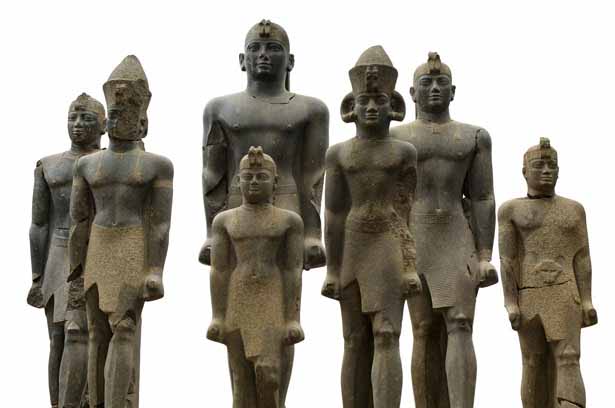
This period is characterized by the country's fracturing kingship. Even in Ramesses XI's day, the Twentieth dynasty of Egypt was losing its grip on power in the city of Thebes, whose priests were becoming increasingly powerful. After his death, his successor Smendes I ruled from the city of Tanis, and the High Priests of Amun at Thebes ruling the south of the country in the period of the Twenty-first dynasty of Egypt. In fact, this division was less significant than it seems, since both priests and pharaohs came from the same family.
The country was firmly reunited by the Twenty-Second Dynasty founded by Shoshenq I in 945 BC (or 943 BC), who descended from Meshwesh immigrants, originally from Ancient Libya. This brought stability to the country for well over a century, but after the reign of Osorkon II, particularly, the country had effectively shattered in two states with Shoshenq III of the Twenty-Second Dynasty controlling Lower Egypt by 818 BC while Takelot II and his son Osorkon (the future Osorkon III) ruled Middle and Upper Egypt.
In Thebes, a civil war engulfed the city between the forces of Pedubast I, who had proclaimed himself Pharaoh versus the existing line of Takelot II/Osorkon B. These two factions squabbled consistently and the conflict was only resolved in Year 39 of Shoshenq III when Osorkon B comprehensively defeated his enemies. He proceeded to found the Upper Egyptian Libyan Dynasty of Osorkon III - Takelot III - Rudamun, but this kingdom quickly fragmented after Rudamun's death with the rise of local city states under kings such as Peftjaubast of Herakleopolis, Nimlot of Hermopolis, and Ini at Thebes.
The Nubian kingdom to the south took full advantage of this division and political instability. Prior to Piye's Year 20 campaign into Egypt, the previous Nubian ruler - Kashta - had already extended his kingdom's influence over into Thebes when he compelled Shepenupet, the serving Divine Adoratice of Amun and Takelot III's sister, to adopt his own daughter Amenirdis, to be her successor.
Then, 20 years later, around 732 BC his successor, Piye, marched North and defeated the combined might of several native Egyptian rulers: Peftjaubast, Osorkon IV of Tanis, Iuput II of Leontopolis and Tefnakht of Sais. Piye established the Twenty-Fifth Dynasty and appointed the defeated rulers as his provincial governors. He was succeeded first by his brother, Shabaka, and then by his two sons Shebitku and Taharqa respectively.
The reunited Nile valley empire of the 25th dynasty was as large as it had been since the New Kingdom. The 25th dynasty ushered in a renaissance period for Ancient Egypt. Religion, the arts, and architecture were restored to their glorious Old, Middle, and New Kingdom forms. Pharaohs, such as Taharqa, built or restored temples and monuments throughout the Nile valley, including at Memphis, Karnak, Kawa, Jebel Barkal, etc.
It was during the 25th dynasty that the Nile valley saw the first widespread construction of pyramids (many in modern Sudan) since the Middle Kingdom. The 25th dynasty ended with its rulers retreating to their spiritual homeland at Napata. It was there (at El-Kurru and Nuri) that all 25th dynasty pharaohs are buried under the first pyramids to be constructed in the Nile valley in centuries. The Napatan dynasty led to the Kingdom of Kush, which flourished in Napata and Meroe until at least the 2nd century A.D.
The international prestige of Egypt had declined considerably by this time. The country's international allies had fallen firmly into the sphere of influence of Assyria and from about 700 BC the question became when, not if, there would be war between the two states. Despite Egypt's size and wealth, Assyria had a greater supply of timber, while Egypt had a chronic shortage, allowing Assyria to produce more charcoal needed for iron-smelting and thus giving Assyria a greater supply of iron weaponry. This disparity became critical during the Assyrian invasion of Egypt in 670 BC. Consequently, Pharaoh Taharqa's reign and that of his successor, (his cousin) Tanutamun, were filled with constant conflict with the Assyrians. In 664 BC the Assyrians laid the final blow, sacking Thebes and Memphis.
Instead, Egypt was ruled (from 664 BC, a full eight years prior to Tanutamun's death) by the Twenty-Sixth Dynasty, client kings established by the Assyrians who successfully brought about Egypt's political independence under their reign. Psamtik I was the first to be recognized by them as the King of the whole of Egypt, and he brought increased stability to the country in a 54 year reign from the city of Sais.
Four successive Saite kings continued guiding Egypt into another period of peace and prosperity from 610-525 BC. Unfortunately for his dynasty, a new power was growing in the Near East - Persia. Pharaoh Psamtik III had succeeded his father Ahmose II for only 6 months before he had to face the Persian Empire at Pelusium. The Persians had already taken Babylon and Egypt was no match. Psamtik III was defeated and briefly escaped to Memphis, before he was ultimately imprisoned and, later, executed at Susa, the capital of the Persian king Cambyses, who now assumed the formal title of Pharaoh.
The historiography of this period is disputed for a variety of reasons. Firstly there is a dispute about the utility of a very artificial term that covers an extremely long and complicated period of Egyptian history.
The Third Intermediate period includes long periods of stability as well as chronic instability and civil conflict: its very name rather clouds this fact. Secondly there are significant problems of chronology stemming from several areas: first, there are the difficulties in dating common to all of Egyptian chronology but these are compounded due to synchronicisms with Biblical Archaeology that also contain heavily disputed dates. Finally, some Egyptologists and biblical scholars, such as Kenneth Kitchen, or David Rohl have novel or controversial theories about the family relationships of the dynasties comprising the period.